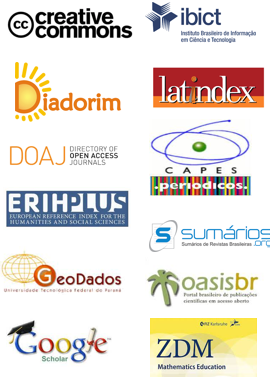Formas de Participação do Professor de Matemática ao Utilizar Materiais Curriculares Educativos em Sala de Aula
DOI:
https://doi.org/10.17921/2176-5634.2016v9n2p%25pResumo
Este estudo teve como objetivo compreender as formas de participação do professor na aula de Matemática, ao utilizar materiais curriculares educativos, ou seja, materiais didáticos que além de apoiarem o aluno, possuem elementos de apoio ao fazer docente. Consideramos estes materiais como objetos de fronteira para subsidiar esta compreensão. Duas professoras foram entrevistadas e observadas ao fazerem uso desses materiais. A análise qualitativa sugere que professores podem participar de uma aula de matemática seguindo as sugestões e exemplos do material, diversificando estratégias de ensino da Matemática, ou ainda, usando o material como acessório na sua aula. Estes modos de participar estão relacionados ao reconhecimento das experiências reificadas no objeto de fronteira como similares ou não ao repertório da comunidade social escolar.
Referências
AGUIAR, W. R.; OLIVEIRA, A. M. P. A Transformação dos Textos dos Materiais Curriculares Educativos por Professores de Matemática: uma análise dos princípios presentes na prática pedagógica. Boletim de Educação Matemática, v. 28, n. 49, p. 580-600, 2014.
ALRØ, H.; SKOVSMOSE, O. Dialogue and learning in mathematics education: intention, reflection, critique. Dordretch: Kluwer, 2002.
ANGROSINO, M. V. Recontextualizing Observation. In: DENZIN, N. K.; LINCOLN, Y. S. Handbook of qualitative research. Thousand Oaks: Sage, p. 729 – 745, 2005.
BALL, D. L.; COHEN, D.. Reform by the Book: What Is - or Might Be - the Role of Curriculum Materials in Teacher Learning and Instructional Reform?.Educational Researcher, Vol. 25, n. 9, p. 6-8, 1996.
BARTON, D.; TUSTING, K. Beyond Communities of Practices. Cambridge: Cambridge University Press, 2005
BROWN, M. W. The Teacher-Tool Relationship: Theorizing the Design and Use of Curriculum Materials. In: REMILLARD, J.T.; HERBEL-EISENMANN, B.A.; LLOYD, G.M. (Eds.). Mathematics teachers at work: Connecting Curriculum Materials and Classroom Instruction. Nova Iorque: Routledge, 2009.p. 17–36.
CHARMAZ, K. Constructing Grounded Theory: a practical guide through qualitative analysis. Londres: Sage, 2006.
CHOPPIN, J. Learned adaptations: Teachers’ understanding and use of curriculum resources. Journal of Mathematics Teacher Education, v. 14, n. 5, p. 331-353, 2011.
DAVIS, E. A.; NELSON, M.; BEYER, C. Using educative curriculum materials to support teachers in developing pedagogical content knowledge for scientific Modelling. In: Proceedings of the NARST 2008 Annual Meeting. 2008. p. 3-8.
DENZIN, N.K.; LINCOLN. Introduction. In: DENZIN, N. K.; LINCOLN, Y. S. Handbook of qualitative research. Thousand Oaks: Sage, p. 1 – 29, 2005.
FONTANA, A.; FREY, J. H. The Interview From Neutral Stance to Political Involvement.In: DENZIN, N. K.; LINCOLN, Y. S. Handbook of qualitative research. Thousand Oaks: Sage, p. 695 – 728, 2005.
FREIMAN, V.; LIRETTE-PITRE, N. Building a virtual learning community of problem solvers: example of CASMI community. ZDM Mathematics Education, v. 41, p.245–256, 2009.
GOMES, S. C. Ensino de Trigonometria numa Abordagem Histórica: um produto educacional. Bolema, Rio Claro (SP), v. 27, n. 46, p. 563-577, 2013.
HOYLES, C. et al. Corner stone Mathematics: designing digital technology for teacher adaptation and scaling. ZDM Mathematics Education, v. 45, n. 7, p. 1057-1070, 2013.
LAVE, J.; WENGER, E. Situated learning: Legitimate peripheral participation. New York: Cambridge University Press, 1991.
LIBBRECHT, P. Re-use? Is this re-use? Revisiting an objective of the Intergeo project. ZDM, v. 4, p. 353–358 2011;
LLOYD, G. M.; REMILLARD, J. T.; HERBEL-EISENMANN, B. A.. Teachers’ Use of Curriculum Material: An Emerging Field. In: REMILLARD, J.T.; HERBEL-EISENMANN, B.A.; LLOYD, G.M. (Eds.). Mathematics teachers at work: Connecting Curriculum Materials and Classroom Instruction. New York: Routledge, 2009.p. 3–14.
NIE, B. et al. An investigation of teachers’ intentions and reflections about using Standards-based and traditional textbooks in the classroom. ZDM, v. 45, n. 5, p. 699-711, 2013.
REMILLARD, J.; BRYANS, M. Teachers' orientations toward mathematics curriculum materials: Implications for teacher learning. Journal of Research in Mathematics Education.35(5), p. 352-388, 2004.
SCHNEIDER, R. M.; KRAJCIK, J.The role of educative curriculum materials in reforming science education. In: AERA Meeting, Spring. 2000.
TRGALOVA, J.; SOURY-LAVERGNE, S.; JAHN, A. P..Quality assessment process for dynamic geometry resources in Intergeo project. ZDM, v. 43, n. 3, p. 337-351, 2011.
VILAS BOAS, J. O MATERIAL CURRICULAR EDUCATIVO COMO APOIO NO CRUZAMENTO DAS FRONTEIRAS CULTURAIS DO ENSINO DE MATEMÁTICA. I Colóquio Internacional sobre ensino e didática das ciências. Anais... Feira de Santana: Bahia, 2014
WENGER, E. Comunities of Pratices Learning, Meaning, and Identity. Cambridge: Cambridge University Press, 1998.


